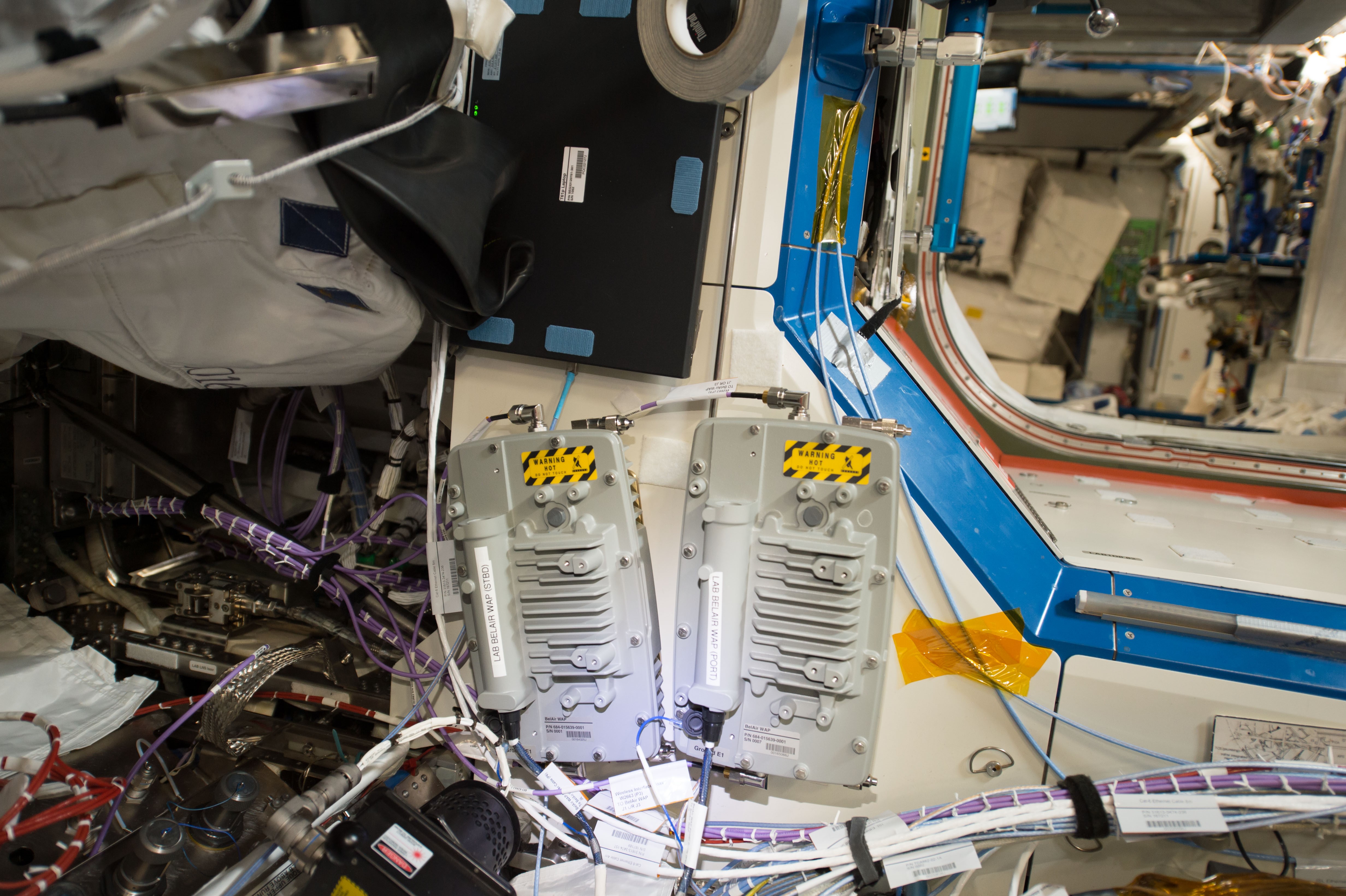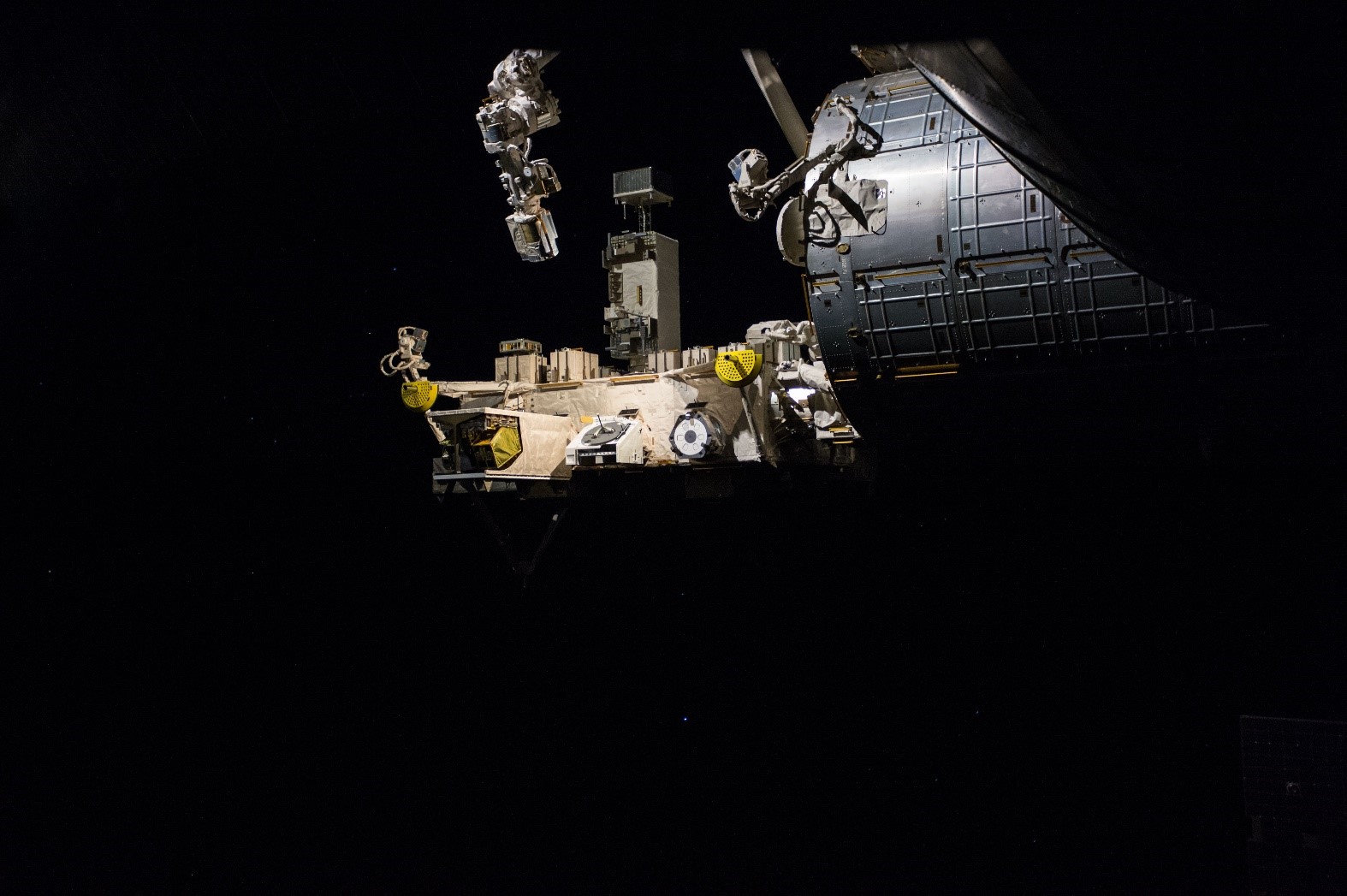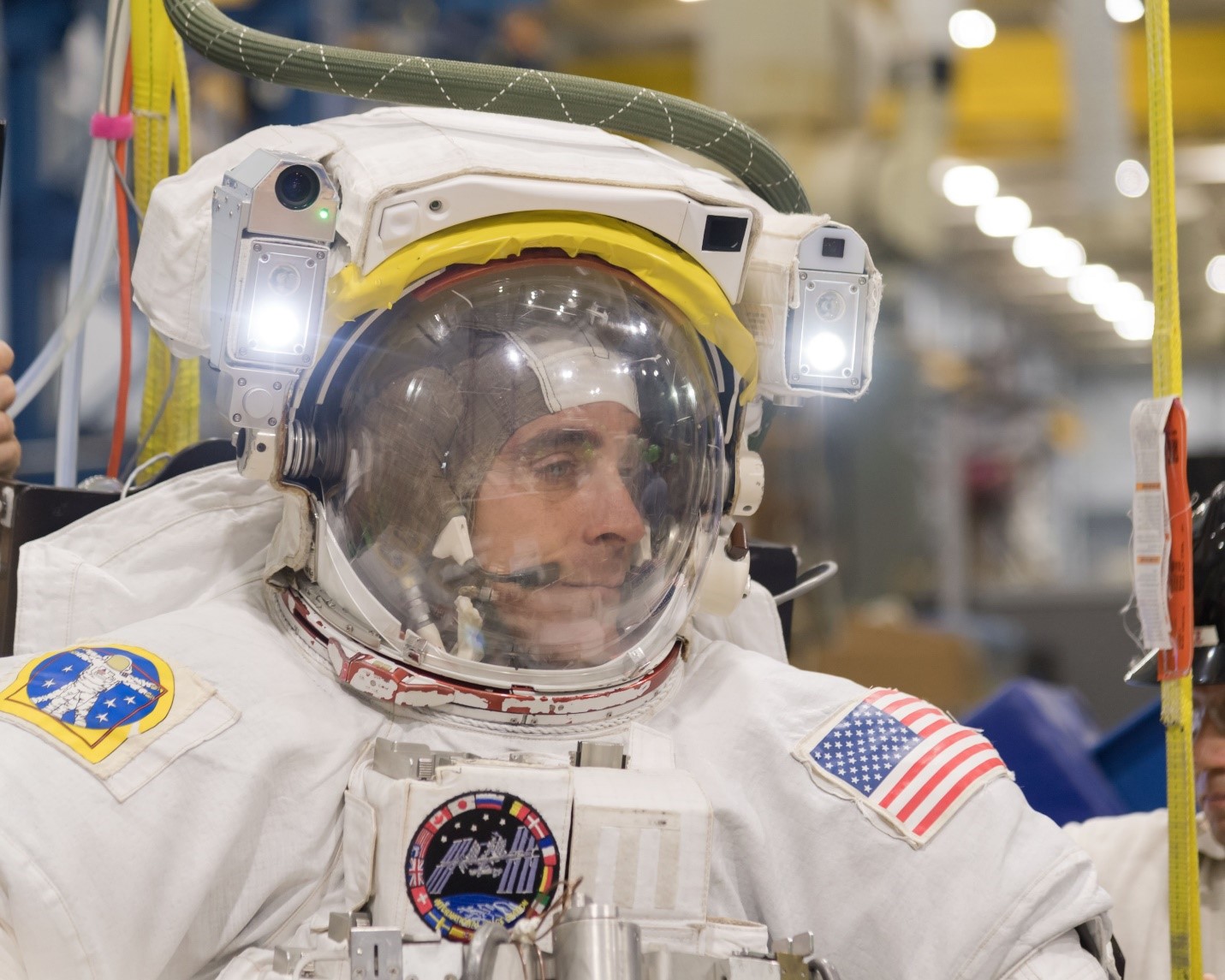The idea for external Wi-Fi® on International Space Station (ISS or Space Station) formed during the later days of the Space Shuttle program as the concept of “commercial off the shelf” technology was becoming more accepted in the human space program. The station was transitioning from the assembly phase to an orbiting laboratory supporting payloads, and technology had changed greatly since the ISS was originally designed in the 1990s. Wi-Fi offered a way to deliver relatively high data rate services to payloads outside of ISS in areas that had low data rate wiring or no connection at all.
The team had a challenge. The cables for the Space Station antennas that communicate with the space suit radios pass outside through vacuum-tight coaxial bulkhead connectors. The concept called for using spare pins in this existing connector. If this connector was removed to install the Wi-Fi antennas, the astronauts outside the ISS would have no communication with the crew inside or with the ground controllers while making the connections. The only backup for the communication was the suit radio in the Space Shuttle and there were only two flights left. The team scrambled to build and test the external cable and antennas for the harsh environment of space. The components were loaded onboard the Space Shuttle with only days to spare.
2011: Mounting antennas outside the Space Station
In May 2011 during the final flight of Space Shuttle Endeavor, astronauts Drew Feustel and Greg Chamitoff installed an antenna clamped onto a handrail on top of the Destiny module. That excursion was cut short by the failure of a carbon dioxide (CO2) sensor in Chamitoff’s space suit. Five days later, Feustel returned with astronaut Mike Fincke to install a second antenna and make the connection to the pressure shell bulkhead with the Space Shuttle providing communications to the ground. The antennas and cable connections were later tested by using two access points connected to each antenna in backhaul mode from inside the Space Station, a crude method that offered some confidence that the components were functioning.
The Space Shuttle program ended and new Space Station payloads began incorporating Wi-Fi, but it would be several years before these payloads were ready. In the meantime, the antennas stayed in space, cycling several times daily through a temperature range from as hot as 60 degrees Celsius (140 degrees Fahrenheit) to as cold as negative 70 degrees Celsius (negative 94 degrees Fahrenheit). The antennas continued unused until Memorial Day on May 30, 2016, when the Station’s first external Wi-Fi access point – a commercially packaged industrial grade access point inside the Destiny module – was powered on and began beaconing for clients.
Figure 1: Two Wi-Fi access points connected by wire to external antennas
2016: First Wi-Fi network in space
In early August that year, the NanoRacks External Platform (NREP) was delivered to the ISS. Robotically installed on a porch outside the Japanese Experiment Module, the platform swaps commercial payloads on a regular basis, experiments that have included a hyperspectral imager. Engineers waited on console in the Mission Control Center anticipating how the first client would connect and contemplating all the things that might have gone wrong in the intervening years. Finally, when the checklists were complete, the NREP was powered to life and data was streamed over the first Wi-Fi network in the vacuum of space.
Figure 2: NREP is the white wedge under the robotic manipulator which streamed data over the first Wi-Fi network in space
A month later, astronauts Jeff Williams and Kate Rubins installed two high-definition cameras on the Space Station’s long truss. They mounted the cameras beside the existing standard definition cameras, tapped into luminaire power, and the video began streaming back through Wi-Fi. The external system was still not well characterized, and the bare minimum acceptable performance was that Wi-Fi usage could be scheduled so that only one client would load the Wi-Fi (effectively a dedicated communication link). Fortunately with three high-rate clients, the system did function as a wireless extension of the onboard network and multiple clients have never needed to coordinate schedules. In April of 2017, the external wired backbone network was enhanced with a Gigabit Ethernet switch upgrade from Fast Ethernet that would be useful for later external Wi-Fi expansion. Near the end of the first year of operation, astronaut Jack Fischer installed a second pair of antennas on the underside of the Destiny module. The two pairs were briefly operated as zenith and nadir coverage before the four antennas were reconnected as port and starboard pairs – a quick shirt-sleeve indoor task.
2017: Two more clients, and a third AP
An astronomy platform called MUSES was robotically installed on the truss in June of 2017. MUSES is the only client to use a highly directional antenna, a strategy that has since been abandoned in favor of expanding the reach and capacity of the infrastructure. Another digital camera was installed by astronaut Joe Acaba. Then in March of 2018, astronauts Drew Feustel and Oleg Artemyev installed a pair of antennas on the Tranquility module. This infrastructure improved Wi-Fi coverage on the port side of the station in advance of the robotically installed EcoSTRESS thermal Earth imager on the Japanese porch.
2018: Going mobile – clients in space suits and AP’s in the docking corridor
Ricky Arnold and Drew Feustel installed a pair of stationary high-definition cameras on the forward end of the Harmony module in June of 2018, also installing a temporary Ethernet cable so that the cameras provide Wi-Fi coverage in this shadow region off the bow, as well as providing a fixed view of the docking corridor. Sight-lines between these access points and installed payloads are blocked, and the surrounding space is quote black, yet several payloads routinely connect by using signals bounced against modules, thermal radiators, and other surfaces.
Anne McLain and Nick Hague became the first astronauts to wear Wi-Fi in a space suit during a spacewalk on March 22, 2019 to replace Space Station rechargeable batteries with new technology. A wireless data logger was retrofitted into the suits, making the space suits the first mobile clients of the wireless network. The logger was developed after several dangerous and undetected coolant leaks, and collected new data that couldn’t be relayed through existing special-purpose space suit radios. McLain installed ten, gigabit Ethernet cables through the hull to the outside of the station during an April 2019 spacewalk. In the future as needed these can be routed onto the truss to connect additional access points to the upgraded gigabit wired network inside ISS.
2019: Maintenance by wireless
Later in July, the Wi-Fi team was faced with another challenge of updating wireless access point (WAP) firmware through the wireless link only. If anything went wrong, the WAPs would be useless and millions of dollars of science payloads and cameras would be inoperable. The flight control team drilled the procedures to make sure everything was perfect and began systematically updating all of the units. Then a certificate error occurred that hadn’t been seen on the ground. The update was completed, but only after some tense days to understand the error and carefully recover.
During a spacewalk last August, astronauts Nick Hague and Andrew Morgan carried a portable high-definition camera that they clamped to a hand rail that streamed high-definition video on battery power using Wi-Fi. A pair of high-definition helmet cameras are also presently on-board the Space Station awaiting installation into the suits – these too incorporate Wi-Fi.
Figure 3: Astronaut Chris Cassidy wears the high-definition digital camera upgrade, upper left. The two legacy cameras use standard definition analog signaling, upper right.
The external Wi-Fi system on ISS was made possible by the ecosystem surrounding the standards and interoperability created by organizations like IEEE and Wi-Fi Alliance®. The advancements in reliability driven by commercial manufacturers, particularly with industrial Wi-Fi products, have resulted in the successful use of off-the-shelf networking components on the ISS. Building on the ubiquity Wi-Fi has gained on the ground, after nine years in concept and four years of powered operation, it is hard to imagine the ISS without external Wi-Fi.
Trade names and trademarks are used in this report for identification only. Their usage does not constitute an official endorsement, either expressed or implied, by the National Aeronautics and Space Administration.
The statements and opinions by each Wi-Fi Alliance member and those providing comments are theirs alone, and do not reflect the opinions or views of Wi-Fi Alliance or any other member. Wi-Fi Alliance is not responsible for the accuracy of any of the information provided by any member in posting to or commenting on this blog. Concerns should be directed to info@wi-fi.org.







Add new comment